You can listen to Hoosier History Live! live on the air each Saturday, or listen online at the WICR website during the broadcast on any computer with speakers, anywhere, or on a smartphone. We invite you to visit our website!
April 7 show
Dan Patch, the first superstar racehorse
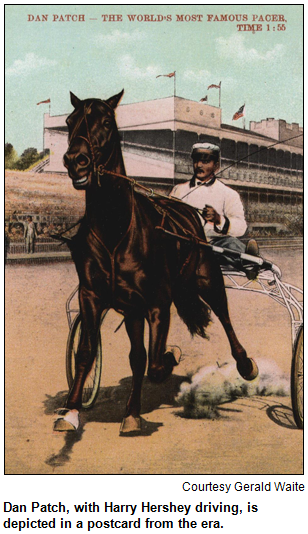 According to many sports historians, the greatest athlete of the early 1900s was a Hoosier - and he wasn’t a baseball player, a bicyclist, a boxer or even a human being.
According to many sports historians, the greatest athlete of the early 1900s was a Hoosier - and he wasn’t a baseball player, a bicyclist, a boxer or even a human being.
Dan Patch was a racehorse who became a top national celebrity, never lost a race on the grand circuit of harness racing and was hailed as the "Epitome of Excellence in American Sports."
Yet this superstar, who eventually endorsed an array of products from sleds to washtubs, had gangly, crooked legs at his birth in 1896. He was foaled in a barn in Oxford, a western Indiana town that continues to celebrate an annual Dan Patch Days Festival in honor of the famous son. (This year's event, the 43rd festival, will be Sept. 7-9 at Rommel Park in Oxford.)
A pacer who stunned spectators in 1900 at the Benton County Fairgrounds with an incredible win in his first race, Dan Patch initially was owned by local storekeeper Daniel Messner Jr. The barn where "the Patch" was foaled and raised still stands and is owned by Messner's grandson.
To explore the life of the racehorse that captivated Americans (even a popular dance, known as the "Dan Patch Two-Step," was composed in his honor, as was a "Dan Patch March"), Nelson will be joined in studio by two guests. They are Oxford resident Bob Glaspie, who owns a vast collection of Dan Patch memorabilia, and Gerald Waite, a lecturer emeritus at Ball State University who has written extensively about the legendary horse.
Dan Patch also has been the subject of a bestselling biography, Crazy Good: The True Story of Dan Patch, the Most Famous Racehorse in America (Simon & Schuster, 2008) by Charles Leerhsen, whom our guest Bob escorted around Oxford during his research.
 Dan Patch's dominance hurt betting at racetracks because, if the undefeated champ was entered, everyone knew who would win. Other prominent owners also didn't want their racehorses "to submit to the humiliation of being beaten every time," according to an award-winning cover story written by our guest Gerald Waite for Traces of Indiana and Midwestern History magazine. So for several years, "the Patch" raced against a stopwatch, essentially competing against himself to set new world records.
Dan Patch's dominance hurt betting at racetracks because, if the undefeated champ was entered, everyone knew who would win. Other prominent owners also didn't want their racehorses "to submit to the humiliation of being beaten every time," according to an award-winning cover story written by our guest Gerald Waite for Traces of Indiana and Midwestern History magazine. So for several years, "the Patch" raced against a stopwatch, essentially competing against himself to set new world records.
Our guest Bob Glaspie, 86, a farmer who grew up in Benton County, owns one of the historic stopwatches, as well as more than 300 other pieces of memorabilia. They include Dan Patch-endorsed children's wagons (they were sold in three styles), a straight razor, a pocket knife and a clothes wringer.
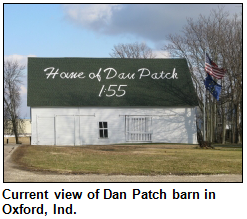 "Probably the rarest item is Dan Patch billiard chalk," he says. "This chalk has never touched a cue, and it's in the original box."
"Probably the rarest item is Dan Patch billiard chalk," he says. "This chalk has never touched a cue, and it's in the original box."
He also owns a horseshoe discovered in the Messner barn that, Bob says, "almost certainly was worn by Dan Patch."
The wonder horse had multiple owners, concluding with Marion W. Savage, a Minneapolis-based entrepreneur and master promoter who pioneered much of the product licensing. (In addition to the businesses that purchased the rights to the racehorse's name and image, many others undoubtedly used them without permission, according to Gerry Waite's article in Traces.) In 1902, politicians even campaigned for office "by handing out Dan Patch cigars and balloons to voters," Gerry noted.
 Yet the subject of so much lavish praise apparently did not let the acclaim go to his head. Dan Patch, Gerry wrote, was "said to be as gentle as a Newfoundland dog."
Yet the subject of so much lavish praise apparently did not let the acclaim go to his head. Dan Patch, Gerry wrote, was "said to be as gentle as a Newfoundland dog."
And here’s how our upcoming guest described the horse's reaction to an early celebration in his honor at the town square in Oxford:
"Accounts of the time remarked about the almost humanlike sense the horse showed in recognizing friends, dancing to the music, understanding what was said to him, and other characteristics of superior intelligence."
In retirement, Dan Patch enjoyed railroad tours to meet adoring fans across the country. He traveled in a specially designed, private railcar decorated with his portrait on the exterior. Some other facts:
- On the exterior of the Indiana State Museum, where the 92 counties are honored with icons, Benton County is represented by Dan Patch, with a depiction of a single, continuous wire bent to his form. (Thanks to our regular listener Judy Burkam for calling our attention to this.)
- Movies about the phenomenal horse include The Great Dan Patch (1949). Bob, our guest, and film historian Eric Grayson advise viewers to ignore the mountains depicted in Indiana scenes featured in the movie, which obviously was not filmed on location.
- Both the wonder horse and Savage, his final owner, took ill at the same time in 1916. They died 32 hours apart.
History Mystery
Cowboy Bob, the children's TV personality popular in central Indiana and beyond, had more than one horse during the long run of his programs, which included Chuckwagon Theater.  His best-known horse was named Skye. Even better known to fans of Cowboy Bob - who appeared regularly on WTTV-Channel 4 from the late 1960s through the 1980s - was his beloved dog.
His best-known horse was named Skye. Even better known to fans of Cowboy Bob - who appeared regularly on WTTV-Channel 4 from the late 1960s through the 1980s - was his beloved dog.
Question: What was the name of Cowboy Bob's dog?
To win the prize, you must call in with the correct answer during the live show and be willing to be placed on the air. Please do not call if you have won a prize from any WICR show during the last two months. The call-in number is (317) 788-3314, and please do not call until you hear Nelson pose the question on the air.
This week's prize is a copy of the book The Dans, and One Was a Racer, by Mary E. Cross. This prize is courtesy of guest Bob Glaspie and his wife, Thelma. Also, you will have an opportunity to read the book in the lap of luxury with a one-night stay at the Crowne Plaza Hotel at Indianapolis Union Station, courtesy of the ICVA.
Roadtrip: Ravine Garden at the IMA
Roadtripper Chris Gahl of the ICVA returns to our airwaves to suggest that we enjoy spring in all its glory at the Ravine Garden on the grounds of the Indianapolis Museum of Art.
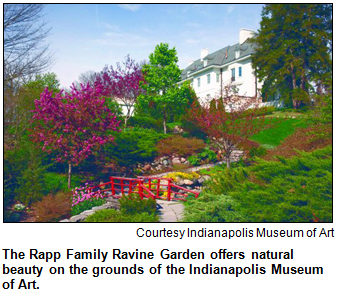 The Ravine Garden is a one-acre hillside garden that descends 40 feet from the terrace of the Lilly House (former home of J.K. Lilly Jr. of Eli Lilly and Co.) down to the Central Canal below. The historic gardens and grounds surrounding the Lilly House, together known as "Oldfields," were designed in the 1920s by landscape architect Percival Gallagher of Olmsted Brothers, the same firm that designed New York's Central Park and Chicago's Lincoln Park.
The Ravine Garden is a one-acre hillside garden that descends 40 feet from the terrace of the Lilly House (former home of J.K. Lilly Jr. of Eli Lilly and Co.) down to the Central Canal below. The historic gardens and grounds surrounding the Lilly House, together known as "Oldfields," were designed in the 1920s by landscape architect Percival Gallagher of Olmsted Brothers, the same firm that designed New York's Central Park and Chicago's Lincoln Park.
The Ravine Garden was restored to Gallagher's original vision in 1998 with funding from George and Peggy Rapp. The dramatic "wild" garden features a cascading stream, three rock-rimmed pools, and more than 19,000 bulbs, perennials, trees and shrubs.
There is no admission charge to enjoy all of the gardens and grounds at the IMA, including the adjacent 100 Acres: The Virginia B. Fairbanks Art & Nature Park. All of the museum grounds are open to the public from dawn until dusk, and free parking is ample. This "hidden oasis" makes for a great value as well as an opportunity to walk around outside and enjoy one of the most stunning landscapes in Indianapolis.
Your Hoosier History Live! team,
Nelson Price, host and creative director
Molly Head, producer, (317) 927-9101
Chris Gahl, Roadtripper
Richard Sullivan, webmaster and tech director
Pam Fraizer, graphic designer
Garry Chilluffo, creative consultant
Michele Goodrich, Jed Duvall, grant consultants
Joan Hostetler, photo historian
Dana Waddell, volunteer-at-large
www.hoosierhistorylive.org





Please tell our sponsors that you appreciate their support: Aesop's Tables, Indiana Historical Society, Lucas Oil, Signature at the Propylaeum and Story Inn.
 Acknowledgments to Print Resources, Indianapolis Marion County Public Library, Monomedia, Indiana Humanities, Indianapolis Convention & Visitors Association, WICR-FM, Fraizer Designs, Heritage Photo and Research Services, Derrick Lowhorn, Samantha Stratton and many other individuals and organizations. We are an independently produced program and are self-supporting through organizational sponsorships, grants and through individual tax-deductible contributions through the Indiana Humanities Council. Visit our website to learn how you can support us financially.
Acknowledgments to Print Resources, Indianapolis Marion County Public Library, Monomedia, Indiana Humanities, Indianapolis Convention & Visitors Association, WICR-FM, Fraizer Designs, Heritage Photo and Research Services, Derrick Lowhorn, Samantha Stratton and many other individuals and organizations. We are an independently produced program and are self-supporting through organizational sponsorships, grants and through individual tax-deductible contributions through the Indiana Humanities Council. Visit our website to learn how you can support us financially.
April 14 show
Broad Ripple neighborhood history in Indy
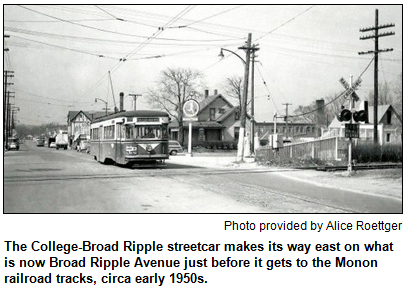 It's our 200th show, ideal to focus on a historic village that became one of the most distinctive neighborhoods in Indianapolis and is about to celebrate its 175th anniversary. The colorful history of Broad Ripple involves bungalows, ducks, the Central Canal, famous son David Letterman, a bygone amusement park, popular nightspots, ethnic restaurants and the 1922 annexation of a bucolic village by Indy.
It's our 200th show, ideal to focus on a historic village that became one of the most distinctive neighborhoods in Indianapolis and is about to celebrate its 175th anniversary. The colorful history of Broad Ripple involves bungalows, ducks, the Central Canal, famous son David Letterman, a bygone amusement park, popular nightspots, ethnic restaurants and the 1922 annexation of a bucolic village by Indy.
Nelson will be joined in studio by two guests with deep connections to the neighborhood: Bridget Carson, a board member of the Broad Ripple Village Association and a key organizer of the upcoming anniversary celebrations, and Alice Ashby Roettger, whose family moved to the community in 1936 and who has researched the histories of many of its homes, sites and notable figures.
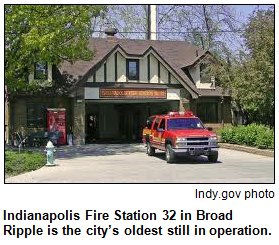 The village dates to April 1837, when it was platted and named Broad Ripple, apparently as a tribute to the ripples created by the White River as it flowed over rocks.
The village dates to April 1837, when it was platted and named Broad Ripple, apparently as a tribute to the ripples created by the White River as it flowed over rocks.
Although early accounts describe hardscrabble labor and revelry by Central Canal workers, Broad Ripple had become a tranquil getaway by the turn of the last century, with visitors from downtown Indy traveling by streetcars (and, later, interurbans) to enjoy fishing, dancing on cruise boats, shopping and other leisurely diversions.
In the early 1900s, White City Amusement Park opened in what's now Broad Ripple Park. Although White City is long gone (a roaring fire in 1908 was among its challenges), other historic structures remain.
Indianapolis Fire Department Station 32 opened about the time of annexation and today is the city's oldest fire station still in use. 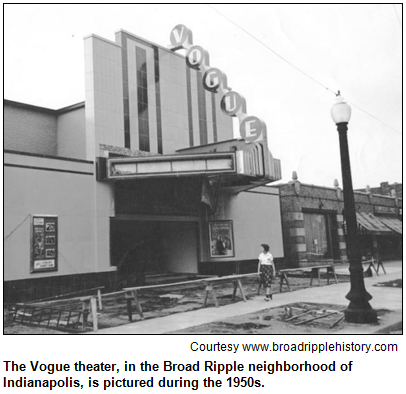 Other landmarks include the Vogue, which opened as a popular movie theater in 1938 and endured a decline (Letterman has said he saw his first X-rated films there during the late 1960s) before a series of renovations that today make it a popular venue for concerts.
Other landmarks include the Vogue, which opened as a popular movie theater in 1938 and endured a decline (Letterman has said he saw his first X-rated films there during the late 1960s) before a series of renovations that today make it a popular venue for concerts.
Many of Broad Ripple's bungalows were built between the late 1910s and mid-1930s. Notable graduates of Broad Ripple High School include Letterman (class of '65), Marilyn Quayle, architect Michael Graves and former Lt. Gov. John Mutz. Some of them attended School 80, as did our guest Alice Ashby Roettger and her future husband; School 80 has been converted into condos, which typifies the clamor for residential living in Broad Ripple.
Upcoming festivities to mark the neighborhood's anniversary include a photo scavenger hunt that kicks off April 17; a race of rubber duckies April 21 on the Central Canal, and a birthday party April 22 that's free and open to the public at the Indianapolis Art Center, 820 E. 67th St. (Fun fact: The art center was designed by Graves, who is nationally renowned as a pioneer of post-Modernist architecture.)
© 2012 Hoosier History Live! All rights reserved.